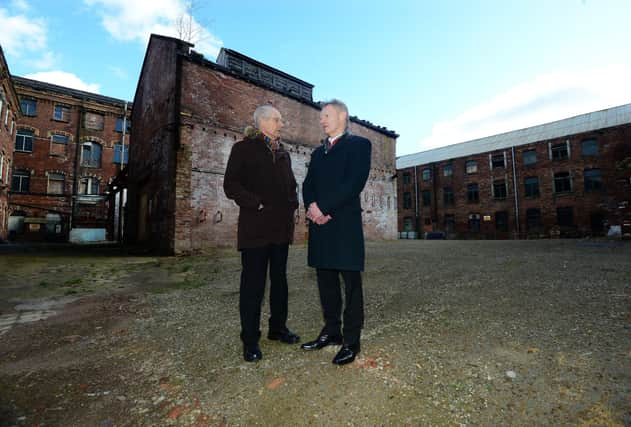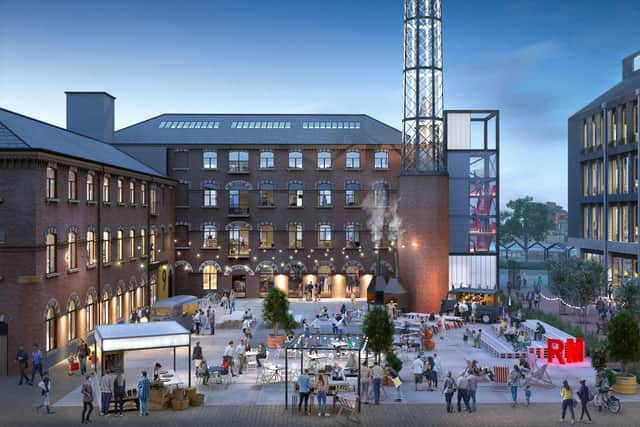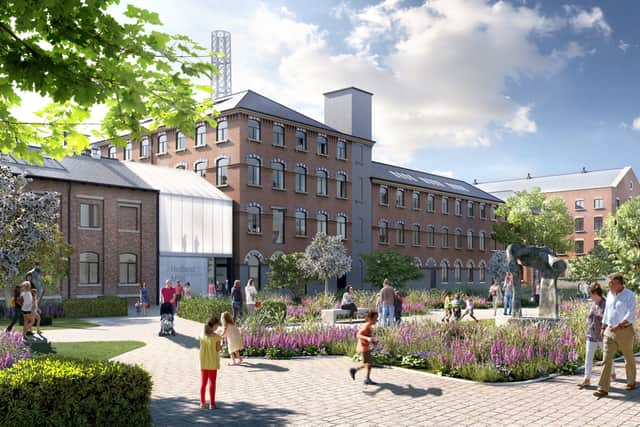Meet the developer weaving a creative future for Wakefield’s Rutland Mills


Paul Kempe is quite honest that not so long ago, he didn’t really know where Wakefield was.
It was with an invite to see The Hepworth from its former deputy director that he made the journey to the city from his base in London around five years ago. The gallery and its exhibitions left him “completely blown away”, but it is the collection of derelict mill buildings next door that have preoccupied him in the years that have followed since.
Advertisement
Hide AdAdvertisement
Hide Ad“I asked what on earth was happening with those mill buildings,” Kempe says. “They are potentially phenomenal but essentially dilapidated.”


The complex he is referring to is known as Rutland Mills. Dating from 1872, the site became a hub for worsted spinning, with knitting yarn manufacturer Patons and Baldwins based there from the 1920s through to the Sixties. But the mills have not been used since 1999.
Still, their state of disrepair did not deter property developer Kempe. His firm had already transformed an empty and unloved estate in London’s Kings Cross into what is said to be Europe’s largest community of independent artists and businesses, with music at its heart, and he saw the potential in Wakefield for a creative hub of similar calibre.
And so he was introduced to then-Wakefield Council leader Peter Box.
Advertisement
Hide AdAdvertisement
Hide Ad“Peter has an exceptional interest in and understanding of music,” says Kempe. “He said he’d like to come down to Tileyard London and have a look. And that was the beginning of things really.


“He came down, loved our community and brought the councillors and regen team down and they loved it. That’s when the conversation started about us creating a Tileyard North at Rutland Mills.”
Work is now getting underway on the flagship scheme, described by current Wakefield Council leader Denise Jeffery as a “gamechanger” for the city.
The redevelopment marks the final stage of Wakefield’s waterfront regeneration ‘masterplan’, which aimed to give the Calder riverside a new lease of life as a “significant cultural destination” in the North of England and included the building of The Hepworth, which opened its doors in 2011.
Advertisement
Hide AdAdvertisement
Hide AdKempe’s vision for Rutland is “a vibrant destination for creative and collaborative partnerships in music, film, TV, design, new media and indeed all facets of the commercial creative sector”.


There are plans for workshops and studios, bars, restaurants and cafes, conference and education spaces and a new hotel.
“If we get it right, Tileyard at Rutland Mills will become a destination - a magnet for people not just in Wakefield but further afield,” Kempe says. “My vision is that people will be coming to Wakefield to experience what will be an incredibly vibrant community - to meet, to eat, to stay in the hotel.
“We are very inclusive and open and want people to experience and enjoy the facilities that we will have. They will be there for the public as well, not just the people based and working at Tileyard North.
Advertisement
Hide AdAdvertisement
Hide Ad“We’re super excited by the prospect. We are committing a huge amount of energy and resources to it and will continue to do so. It will be a success.”
It’s a bold statement to make - though his credentials stand Kempe in good stead for success.
He trained as a solicitor initially - “I gave that up immediately on the day I qualified because I just could never see myself working as a lawyer” - before establishing City and Provincial Properties (CPP) in 1984.
One of the firm’s most notable achievements to date is the development of Tileyard London, with Kempe one of the three-man team behind its creation.
Advertisement
Hide AdAdvertisement
Hide Ad“We acquired the buildings there just before the financial crisis, so not the best timing,” he says. “There was a series of buildings, about 105,000 square feet, mostly empty. There was about 75 or 80 per cent vacant, no creatives whatsoever and it was a very unloved, uninvested estate.”
Kempe had recently invested in a music production company called Goldust - and two of its creators - Michael Harwood and Nick Keynes - were to become part of the team at the helm of Tileyard’s development.
“I’ve always been interested in music generally but had never really immersed myself in it or engaged with it, other than as a consumer,” Kempe says. “I wanted to understand how the industry worked. It was pure interest [investing in Goldust] - never a financial investment to make money.
“But what an incredible happy accident it turned out to be. Without doing that, Tileyard would never have existed and we would never have hatched this plan to turn it into what it is today.”
Advertisement
Hide AdAdvertisement
Hide AdHarwood and Keynes had been in a band called Ultra and, after getting dropped by their label, ended up creating Goldust, writing and producing for a host of pop artists in the early 2000s including Kylie, Liberty X and Natasha Bedingfield.
In 2011, they moved into Kempe’s light industrial estate and the trio began to shape the future of the complex. Tileyard was born.
“It was a tough ask but the long and short of it was we spent six months and tried to contact everyone in the music industry to get them to commit to us building them a studio,” Kempe explains.
A handful of companies said they would sign up and so work began to turn the first of the buildings into ten studios.
Advertisement
Hide AdAdvertisement
Hide Ad“We made it our mantra to deliver to the clients what they wanted so it was very much not a normal landlord and tenant relationship.
“We saw ourselves from day one as trying to facilitate an amazing creative community and trying to give clients more than just space.
“It was a big ask initially because with ten people originally, you haven’t really got much of a community. It was a leap of faith for them.”
The site grew, expanding to include music businesses as well as writers, composers, mixers and producers over the next two years. Suddenly, it had a beating heart and for the first time, people began approaching Kempe and the team about getting on board.
Advertisement
Hide AdAdvertisement
Hide Ad“Fast-forward seven years from there, we have an amazing vibrant community all of which has been totally curated,” Kempe says.
Tileyard is now approaching its tenth anniversary. There’s 1,500 ‘creatives’ based on site, 250 companies and just over 100 studios, all centred around campus meeting places and amenities including a cafe, wellness centre and brewery.
As well as those who work within the music industry, there’s a modelling agency, film and TV production firms, a live gaming organisation and technology firms.
And that’s all alongside in-house management, publishing, and record company Tileyard Music and Tileyard Education, which provides MA courses in a range of music-related areas.
Advertisement
Hide AdAdvertisement
Hide Ad“Virtually every major artist has been up to Tileyard, either to work or meet people that they’re working with,” Kempe says. It’s a base for artists including The Prodigy, Tinchy Stryder, Sigala, Chase & Status and Mark Ronson, who produced big chart hit Uptown Funk on site.
“There’s a lot of happy accidents where people bump into each other, never having met at all. It’s such a close and curated community. The music industry has changed a lot. It used to be very secret - ‘I’m not going to collaborate or share with you in case you steal my ideas’.
“Now virtually every song you hear on the radio has probably got three or four writers and a producer on it. The industry has come to understand that collaboration is the way forward, which is great because that’s what we do. We are facilitators for exceptionally talented people, I would say.”
Kempe had little idea how successful the development would be. But the trio had a firm vision - and they stuck to it, despite the challenges.
Advertisement
Hide AdAdvertisement
Hide Ad“What we did from day one, even though we had huge amounts of empty space and were paying all sorts of charges on it, was agree that we would never let any space to a non-creative company,” Kempe explains.
“That was a tough call when you’ve got the best part of 80,000 sqaure feet empty and you’ve got all sorts of people on your back. In the first couple of years, we were turning people away who would pay good rent but weren’t right for Tileyard. I’m very pleased that we stuck to our guns on that despite the financial pain.
“Every time I go up to Tileyard, I get a real buzz and am super excited by it. It’s been an amazing journey personally for me and continues to be.”
Kempe and his team now refer to Rutland Mills as Tileyard North. “We are wanting this to be a northern powerhouse extension of Tileyard London, servicing not just Wakefield and the wider region but the whole north of England.
Advertisement
Hide AdAdvertisement
Hide Ad“Apart from jobs, which are super important, this will create a place for people to come and work in a curated, creative community, which is going to be hugely positive in terms of empowering people in the north.
“And I think if Tileyard London is anything to go by, any person who joins our community is on a real growth path.”
Hope to open by start of 2023
Paul Kempe says his aim is to have phase one of Tileyard North in the Rutland Mills complex redeveloped by December 2022.
“In terms of jobs, we’re going to be delivering hundreds on site, which will be a major benefit for the area,” Kempe says. “There’s the possibility of having some post-production studios, which could tie in to Channel 4 in Leeds. We are definitely going to run an education programme there too and we have already been in talks with some universities.”
Advertisement
Hide AdAdvertisement
Hide AdHe praised the support of “forward-thinking” Wakefield Council, saying it had put “the benefits of people in the area first” and said the Government had “made it clear” that it was committed to enhancing transport links between northern communities, which would give people more opportunities to work and visit Rutland.
Comment Guidelines
National World encourages reader discussion on our stories. User feedback, insights and back-and-forth exchanges add a rich layer of context to reporting. Please review our Community Guidelines before commenting.